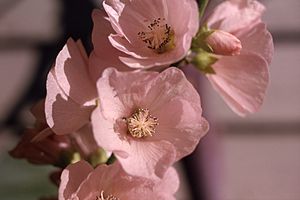Streambank wild hollyhock facts for kids
Quick facts for kids Streambank wild hollyhock |
|
|---|---|
 |
|
| Scientific classification | |
| Genus: |
Iliamna
|
| Species: |
rivularis
|
Iliamna rivularis, also known as the streambank wild hollyhock, is a type of plant that lives for many years (a perennial). It belongs to the Malvaceae family, which includes other plants like cotton and hibiscus.
What is Streambank Wild Hollyhock?
Plant Appearance and Size
This plant can grow quite tall, usually between 3 to 6 feet high. It grows from a strong, woody base called a caudex. The plant produces many flowers grouped together in dense clusters called racemes.
Flower Color and Blooming Time
The flowers are a pretty soft lavender-pink color. You can usually see these flowers blooming from June all the way through August.
Leaves of the Plant
The leaves of the streambank wild hollyhock are shaped like a heart (cordate). They also have five to seven lobes, which means they have rounded sections that stick out, making them look a bit like a hand.
Seeds and How They Grow
The seeds of this plant have a very tough outer shell. Because of this hard coat, the seeds can stay alive in the soil for more than 50 years! This is a super long time for a seed to wait.
How Wildfire Helps Seeds Grow
Interestingly, these seeds often start to grow after a wildfire. The heat from the fire helps to break open their hard shell, allowing the tiny plant inside to sprout. This process is called scarification.
Where Does Streambank Wild Hollyhock Grow?
Natural Habitat and Locations
This plant loves sunny places in the mountains. You can find it growing along streambanks, in open meadows, and on forest slopes.
It is native to areas east of the Cascade Range. This includes parts of British Columbia and Alberta in Canada, and states like Montana, Oregon, and Colorado in the USA.
Special Case: Iliamna rivularis var. rivularis
There's a specific type of this plant called Iliamna rivularis var. rivularis. It's often known as Iliamna remota or the Kankakee globe-mallow. This variety has had big problems in the eastern USA.
Why This Variety is Struggling
Its numbers have dropped a lot because of changes in how fires happen. For a long time, people have stopped wildfires (fire suppression). This has changed the forest, making it shadier.
Shade makes it hard for the plants to grow and for their seeds to sprout. Remember, these seeds need fire to help them germinate! Without regular fires, the plants struggle to survive and reproduce.

